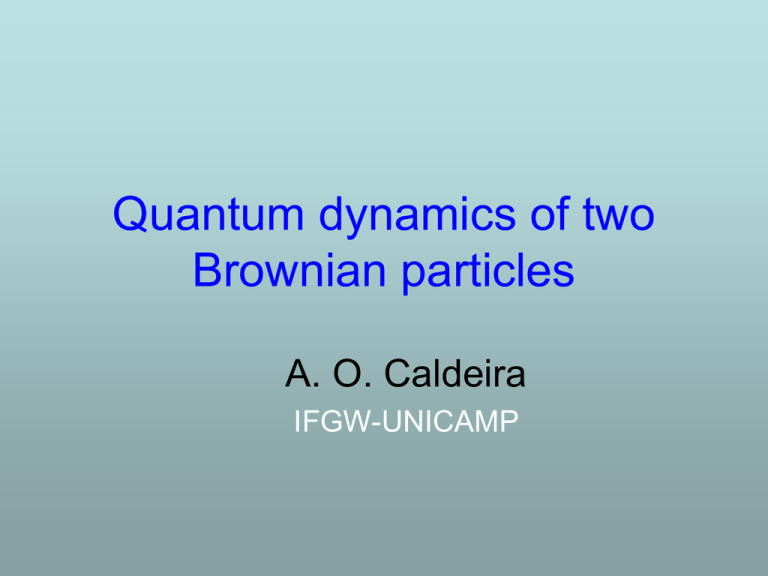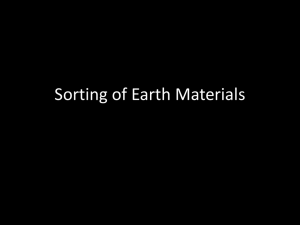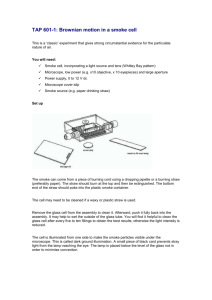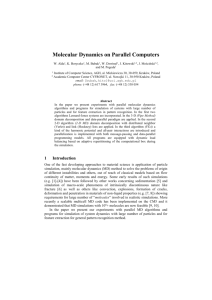Quantum dynamics of two Brownian particles
advertisement

Quantum dynamics of two Brownian particles A. O. Caldeira IFGW-UNICAMP Outline a) Introduction b) Alternative model and effective coupling c) Quantum dynamics d) Results e) Conclusions Introduction Equation of motion of a classical Brownian particle mq q V q f t where ' f t 0 and f t f t ' 2k BT t t ' a) The phenomenological approach Phenomenological approach Dissipative systems are such that H = HS + Hint + HR Two options: i) simple model for HR + classical constraint ii) realistic model for HR Choosing the first one pk2 1 p2 mk k2 qk2 ; HS V q ; H int Ck qqk ; H R 2 2m k 2mk k Ck2 q 2 H CT 2 k 2 mk k Defining the spectral function Ck2 J k k 2mk k one shows that the condition for ohmic dissipation q is if J 0 if Strategy: trace over the variables of R on the time evolution of the density operator of the entire system S+R Effective dynamics depends only on Other forms of the same model Ck qk q 2 k mk k p2 H V (q) 2m where Ck2 k mk k4 2 and k Ck pk pk 2 mk k pk2 k k2 ( qk q ) 2 2 k 2 J ( ) 2 k Ck2 ( k ) mk k 3 k k ( k ) ( ) k Manifestly translational invariant if V(q)=0! Mechanical analogue V(q) Manifestly translational invariant if V(q)=0! If we write the Lagrangian of the whole system as ~ L LS LR LI (notice there is no counter – term! ) where ~ LI ~ ~ Ck qq k with Ck Ck k1 k and go over to the Hamiltonian formalism, we recover the original model (with the appropriate counter – term) , after the canonical transformation p p, q q, pk mk k qk pk and qk mk k Two free Brownian particles (classical) Two independent particles immersed in a medium, if acted by no external force obey mq1 2m q1 f1 (t ) f1 (t ) 0 and and ; 2m f1 (t ) f1 (t ) 4m kT (t t ) mq2 2m q 2 f 2 (t ) f 2 (t ) 0 where where f 2 (t ) f 2 (t ) 4m kT (t t ) Two free Brownian particles (classical) q1 q2 m if q , u q1 q2 , M 2m and 2 2 f1 (t ) f 2 (t ) Mq 2M q f CM (t ) where f CM (t ) ; 2 f CM (t ) 0 and f CM (t ) f CM (t ) 4M kT (t t ) u(t ) 2 u (t ) f R (t ) f R (t ) 0 and where f R (t ) f1 (t ) f 2 (t ) ; f R (t ) f R (t ) 4 kT (t t ) Alternative model and effective coupling Single particle O.S.Duarte and AOC Phys. Rev. Lett 97 250601 (2006) Going over to the Hamiltonian formulation + canonical transformation Alternative model and effective coupling Single particle modelling counter -term Equation of motion Damping kernel Fluctuating force becomes a constant Alternative model and effective coupling Single particle K ( r, t ) d 2k 2 k k k 0 Assumption Resulting equation Im k(0) () cos kr cos t Alternative model and effective coupling Two particles next page Alternative model and effective coupling Two particles modelling For the center of mass and relative coordinates x1 x2 q and u x1 x2 2 Alternative model and effective coupling Two particles Quantum dynamics O.S.Duarte and AOC To appear PRB 2009 Tracing the bath variables from the time evolution of the full density operator one gets for the reduced density operator of the system Quantum dynamics Results Initial reduced density operator x yi New variables are defined qi i and i xi yi in terms of 2 1 2 q1 q2 and v 1 2 and u q1 q2 and as r 2 2 z is the squeeze parameter reduced density operator at any time Results Characteristic function Covariance matrix Eigenvalues of the PT density matrix Logarithmic negativity Results 1.0, kT 104 , k0L 0, 10 Results 1.0, kT 10, k0 L 0, 10 Results z 0, kT 5, k0 L 0, 10 Results 1.0, kT 104 , z 0, 10 Results 1.0, kT 104 , z 0.3, 10 Conclusions 1) Generalization of the conventional model properly describes the dynamics of two Brownian particles. 2) Novel possible effects: static and dynamical effective interaction between the particles. 3) Possibility of two-particle bound states. Analogy with other cases in condensed matter systems; Cooper pairs, bipolarons etc. 4) Dynamical behaviour of entanglement for limiting cases.











